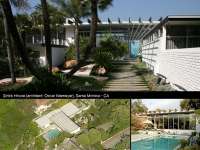“Brasília, Cars, Pools & Other Modernities” is the culmination of a body of work that departs from my experience of growing up in Brasília, Brazil’s planned capital. The project consists of a site-specific action in which a 1970s Volkswagen Brasilia car, loaded with pool cleaning equipment, services the Strick house swimming pool in Santa Monica. Brasília’s architect, Oscar Niemeyer, designed the aforementioned house concurrently with his work on the city. A unique project, the Strick house was built entirely by letter since the socialist architect was never allowed entry to the United States. Although a planned city influenced by social utopian ideals, Brasília’s mythology is best described by some popular phrases such as “Fantasy Island”, “Capital of Hope” and “Capital of Pools.” The last one alludes to the large number of houses with swimming pools within its residential area. Not unlike Los Angeles, pool culture became engrained in the city’s identity through time. This site-specific action draws parallels between the cities of Los Angeles and Brasília. Whereas Los Angeles is the apex of American car culture, Brasília’s urban plan was meant to motivate the then nascent car industry in Brazil. Within this context, the Volkswagen Brasilia model, a national design, became a popular icon. Adopted by pool cleaners for its affordability as a second-hand vehicle, the used Volkswagen became a local anti-hero in contrast to the modern skyline. This project uses a replica of the pool cleaner’s VW Brasilia: beaten-up car with aluminum poles, plastic tubes and brushes attached to the roof hack, and cell phone number signs on the side doors. The vehicle will be brought from Brasília to Santa Monica to assist with the Strick house swimming pool cleaning routine. By collapsing distances and bringing together material evidences of a history dispersed in space and time, this site-specific performance proposes a narrative that complicates the symbolic messages attached to the chosen sites. A Volkswagen Brasilia has already been bought and is currently in Brasília. A series of photographs contrasting the car with the city’s modern skyline has been shot. Preliminary contact with the current Strick House owner has been made and an action plan has been laid out for when the car arrives in Los Angeles. Given the precarious conditions of the old Volkswagen and California DMV limitations, the car will not be driven on the streets but function exclusively as a performance prop. The project will culminate in an exhibition including the car, the pool-cleaning “action,” and a video installation. The Volkswagen Brasilia will be parked in front of the Strick house throughout the course of the exhibition. Gallery visitors will receive directions to visit the house. My interest in the relationship between art and life, history and traces of the real and movement are called to attention by expanding the exhibition beyond the limits of the gallery space into the city. BRASÍLIA, CARS, POOLS & OTHER MODERNITIES
Clarissa Tossin
“Brasília, Cars, Pools & Other Modernities” is the culmination of a body of work that departs from my experience of growing up in Brasília, Brazil’s planned capital. The project consists of a site-specific action in which a 1970s Volkswagen Brasilia car, loaded with pool cleaning equipment, services the Strick house swimming pool in Santa Monica. Brasília’s architect, Oscar Niemeyer, designed the aforementioned house concurrently with his work on the city. A unique project, the Strick house was built entirely by letter since the socialist architect was never allowed entry to the United States. Although a planned city influenced by social utopian ideals, Brasília’s mythology is best described by some popular phrases such as “Fantasy Island”, “Capital of Hope” and “Capital of Pools.” The last one alludes to the large number of houses with swimming pools within its residential area. Not unlike Los Angeles, pool culture became engrained in the city’s identity through time. This site-specific action draws parallels between the cities of Los Angeles and Brasília. Whereas Los Angeles is the apex of American car culture, Brasília’s urban plan was meant to motivate the then nascent car industry in Brazil. Within this context, the Volkswagen Brasilia model, a national design, became a popular icon. Adopted by pool cleaners for its affordability as a second-hand vehicle, the used Volkswagen became a local anti-hero in contrast to the modern skyline. This project uses a replica of the pool cleaner’s VW Brasilia: beaten-up car with aluminum poles, plastic tubes and brushes attached to the roof hack, and cell phone number signs on the side doors. The vehicle will be brought from Brasília to Santa Monica to assist with the Strick house swimming pool cleaning routine. By collapsing distances and bringing together material evidences of a history dispersed in space and time, this site-specific performance proposes a narrative that complicates the symbolic messages attached to the chosen sites. A Volkswagen Brasilia has already been bought and is currently in Brasília. A series of photographs contrasting the car with the city’s modern skyline has been shot. Preliminary contact with the current Strick House owner has been made and an action plan has been laid out for when the car arrives in Los Angeles. Given the precarious conditions of the old Volkswagen and California DMV limitations, the car will not be driven on the streets but function exclusively as a performance prop. The project will culminate in an exhibition including the car, the pool-cleaning “action,” and a video installation. The Volkswagen Brasilia will be parked in front of the Strick house throughout the course of the exhibition. Gallery visitors will receive directions to visit the house. My interest in the relationship between art and life, history and traces of the real and movement are called to attention by expanding the exhibition beyond the limits of the gallery space into the city. BRASÍLIA, CARS, POOLS & OTHER MODERNITIES
Clarissa Tossin

